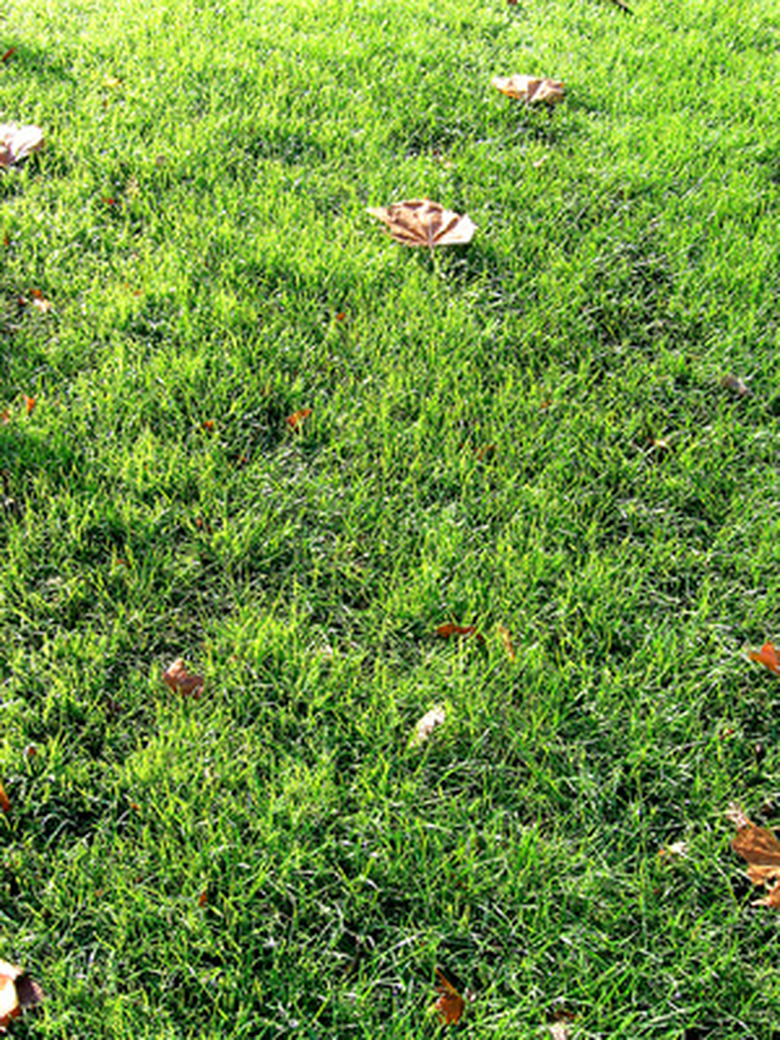How To Plant A Great Lawn In Alabama
Things Needed
- Shovel
- Gypsum
- Compost
- Lime
- Sulfur
- Fertilizer (10-0-0)
- Rototiller
- Garden rake
- Sprinkler
- Garden hose
- Grass sod
- Grass seed
- Utility knife
- Sod roller
- Rain gauge
- Lawn mower
- Seed broadcaster
When it comes to growing lawns, Alabama is a state divided. The northern half of Alabama is located in what is known as a transition zone, with cool winters where warm-season grass goes dormant and warm summers in which cool-season grass will die. The northern part of Alabama is also primarily rocky soil that is dominated by heavy clay. By contrast, the southern half of the state is marked by a coastal climate in which only warm season grass will grow. The soil in this region is primarily delta soil, which is loamy and rich in nutrients.
Preparing the Soil
Step 1
Test your soil in advance of planting your lawn to determine the soil's structure, pH and nutrient content. This will help you to determine which soil amendments you should add to improve your lawn so that grass can flourish. Auburn University maintains a soil laboratory with a focus to providing unbiased advice on soil amendments. You can submit a soil sample for the lab through your local county extension service. An agent with the service can advise you how to take a soil core sample and submit it.
- When it comes to growing lawns, Alabama is a state divided.
- The northern half of Alabama is located in what is known as a transition zone, with cool winters where warm-season grass goes dormant and warm summers in which cool-season grass will die.
Step 2
Purchase soil amendments based on the test in step 1. The most common amendments for the lawn include gypsum to break up heavy clay soil, compost to improve nutrient content and drainage in soil, lime to raise the pH of soil or sulfur to lower the pH, and a nitrogen-rich (10-0-0) fertilizer.
Step 3
Break up your soil with a rototiller to a depth of 6 inches. Spread 4 inches of amendments over the soil and mix them into the soil with the rototiller.
Step 4
Re-grade your soil with a garden rake, smoothing out bumps and removing rocks and sticks. Your lawn should gradually slope away from your home to improve drainage.
Step 5
Water your soil 24 hours before laying sod.
- Purchase soil amendments based on the test in step 1.
- Spread 4 inches of amendments over the soil and mix them into the soil with the rototiller.
Laying Sod and Overseeding
Step 1
Select warm-season sod such as Bermuda grass or zoysia in squares or strips.
Step 2
Unroll strips or lay squares in staggered rows much like brick, tile or home shingles are placed so that there is not a continuous seam in your lawn. Cut the ends of your sod with a utility knife to achieve the uneven lengths required to lay sod this way. Start with a straight edge such as a sidewalk and work your way outward.
Step 3
Roll over your lawn with a sod roller to force the roots of the sod in contact with the soil.
Step 4
Water your lawn between two and four times daily with up to ¼ inch of water each session for the first 14 days to help your lawn's roots develop. Gradually taper your watering program to 1 time weekly with 1 inch of water per session. Use a rain gauge to determine how much water you have used.
- Select warm-season sod such as Bermuda grass or zoysia in squares or strips.
- Unroll strips or lay squares in staggered rows much like brick, tile or home shingles are placed so that there is not a continuous seam in your lawn.
Step 5
Overseed your lawn in the fall in the northern half of the state with a cool-season grass such as ryegrass or bluegrass. To do this, mow your grass so that it is 1 ½ inches tall. Rake over the sod with a garden rake to gouge furrows into the lawn for grass seed. Spread grass seed using a broadcast spreader that you push over your lawn like a lawn mower. Pass over the lawn at least two times, changing the direction you walk with each pass by 90 degrees.
Step 6
Water your lawn frequently to encourage the grass seed to germinate. Once the seed grows 1 ½ inches tall, decrease watering and raise the deck of your mower.
- Overseed your lawn in the fall in the northern half of the state with a cool-season grass such as ryegrass or bluegrass.
- Once the seed grows 1 ½ inches tall, decrease watering and raise the deck of your mower.
